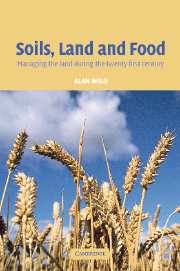Book contents
- Frontmatter
- Contents
- Preface
- Acknowledgements
- 1 Managing land for food production in the twenty-first century: an outline
- 2 Natural resources for sustainable land management
- 3 The development of agriculture and systems of land management
- 4 Maintaining and improving soil fertility
- 5 Land degradation and its control
- 6 Raising yields: use of fertilizers
- 7 Raising yields: water for rainfed crops and irrigation
- 8 Managing change of land use: seven examples
- 9 Increasing and sustaining agricultural production
- 10 Increasing agricultural production: the examples of Africa, India and China
- 11 Prospects and uncertainties
- References
- Index
8 - Managing change of land use: seven examples
Published online by Cambridge University Press: 05 June 2012
- Frontmatter
- Contents
- Preface
- Acknowledgements
- 1 Managing land for food production in the twenty-first century: an outline
- 2 Natural resources for sustainable land management
- 3 The development of agriculture and systems of land management
- 4 Maintaining and improving soil fertility
- 5 Land degradation and its control
- 6 Raising yields: use of fertilizers
- 7 Raising yields: water for rainfed crops and irrigation
- 8 Managing change of land use: seven examples
- 9 Increasing and sustaining agricultural production
- 10 Increasing agricultural production: the examples of Africa, India and China
- 11 Prospects and uncertainties
- References
- Index
Summary
INTRODUCTION
Until 10 000 years ago, hunting, fishing, and gathering seeds, fruits, roots and shellfish provided the food for the small number of people in the world, possibly about five million (Cohen, 1995). By the early part of the nineteenth century the population had risen to about one billion and by the year 2000 to six billion, virtually all of whom depended for their food on the produce from agriculture and fishing. The increase in production from crops has come from an expansion of the arable area and from greater yields per hectare, expansion providing most of the increase until the middle of the twentieth century when technological advances led to substantially increased yields (see Chapter 9).
The evolution of agriculture and its spread into Africa, Asia, Australia, Europe and North and South America was a slow process that occurred over several millennia, starting around 10 000 years ago. Domesticated crop plants and domesticated animals supplied food from land that had previously been the exclusive province of hunter-gatherers; the change to agriculture may be described as the first stage of intensified land use.
Not all was beneficial. Whereas hunter-gatherers relied on the stability of natural and modified ecosystems for their activities, farming inevitably destroyed them. Trees were cut down, pastures were overgrazed, sloping land was cultivated and eroded. Often the end result was impoverishment of much of the land or its entire loss, as described by Chinese, Greek and Roman authors around 2000 years ago (see Chapter 3).
- Type
- Chapter
- Information
- Soils, Land and FoodManaging the Land during the Twenty-First Century, pp. 127 - 154Publisher: Cambridge University PressPrint publication year: 2003



